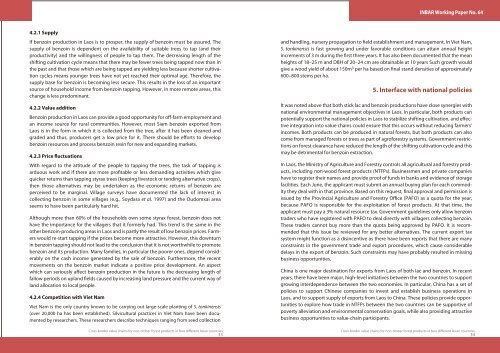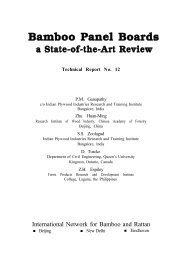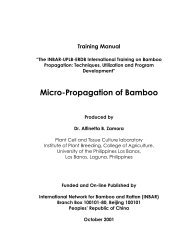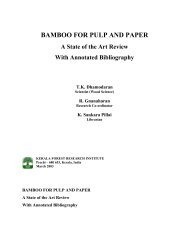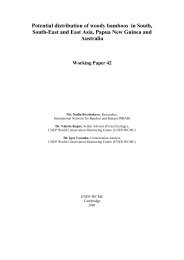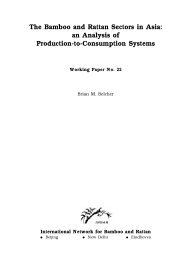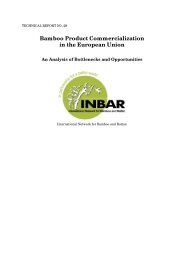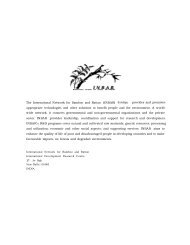Cross-border NTFP value chains - International Network for Bamboo ...
Cross-border NTFP value chains - International Network for Bamboo ...
Cross-border NTFP value chains - International Network for Bamboo ...
Create successful ePaper yourself
Turn your PDF publications into a flip-book with our unique Google optimized e-Paper software.
4.2.1 Supply<br />
If benzoin production in Laos is to prosper, the supply of benzoin must be assured. The<br />
supply of benzoin is dependent on the availability of suitable trees to tap (and their<br />
productivity) and the willingness of people to tap them. The decreasing length of the<br />
shifting cultivation cycle means that there may be fewer trees being tapped now than in<br />
the past and that those which are being tapped are yielding less because shorter cultivation<br />
cycles means younger trees have not yet reached their optimal age. There<strong>for</strong>e, the<br />
supply base <strong>for</strong> benzoin is becoming less secure. This results in the loss of an important<br />
source of household income from benzoin tapping. However, in more remote areas, this<br />
change is less predominant.<br />
4.2.2 Value addition<br />
Benzoin production in Laos can provide a good opportunity <strong>for</strong> o-farm employment and<br />
an income source <strong>for</strong> rural communities. However, most Siam benzoin exported from<br />
Laos is in the <strong>for</strong>m in which it is collected from the tree, after it has been cleaned and<br />
graded and thus, producers get a low price <strong>for</strong> it. There should be eorts to develop<br />
benzoin resources and process benzoin resin <strong>for</strong> new and expanding markets.<br />
4.2.3 Price uctuations<br />
With regard to the attitude of the people to tapping the trees, the task of tapping is<br />
arduous work and if there are more protable or less demanding activities which give<br />
quicker returns than tapping styrax trees (keeping livestock or tending alternative crops),<br />
then those alternatives may be undertaken as the economic returns of benzoin are<br />
perceived to be marginal. Village surveys have documented the lack of interest in<br />
collecting benzoin in some villages (e.g., Soydara et al. 1997) and the Oudomxai area<br />
seems to have been particularly hard hit.<br />
Although more than 60% of the households own some styrax <strong>for</strong>est, benzoin does not<br />
have the importance <strong>for</strong> the villagers that it <strong>for</strong>merly had. This trend is the same in the<br />
other benzoin-producing areas in Laos and is partly the result of low benzoin prices. Farmers<br />
would re-start tapping if the prices become more attractive. However, this downturn<br />
in benzoin tapping should not lead to the conclusion that it is not worthwhile to promote<br />
benzoin and its production. Many families, in particular the poorer ones, depend considerably<br />
on the cash income generated by the sale of benzoin. Furthermore, the recent<br />
movements on the benzoin market indicate a positive price development. An aspect<br />
which can seriously aect benzoin production in the future is the decreasing length of<br />
fallow periods on upland elds caused by increasing land pressure and the current way of<br />
land allocation to local people.<br />
4.2.4 Competition with Viet Nam<br />
Viet Nam is the only country known to be carrying out large-scale planting of S. tonkinensis<br />
(over 20,000 ha has been established). Silvicultural practices in Viet Nam have been documented<br />
by researchers. These researchers describe techniques ranging from seed collection<br />
<strong>Cross</strong>-<strong>border</strong> <strong>value</strong> <strong>chains</strong> <strong>for</strong> non-timber <strong>for</strong>est products in four dierent Asian countries<br />
33<br />
INBAR Working Paper No. 64<br />
and handling, nursery propagation to eld establishment and management. In Viet Nam,<br />
S. tonkinensis is fast growing and under favorable conditions can attain annual height<br />
increments of 3 m during the rst three years. It has also been documented that the mean<br />
heights of 18–25 m and DBH of 20–24 cm are obtainable at 10 years Such growth would<br />
give a wood yield of about 150m 3 per ha based on nal stand densities of approximately<br />
600–800 stems per ha.<br />
5. Interface with national policies<br />
It was noted above that both stick lac and benzoin productions have close synergies with<br />
national environmental management objectives in Laos. In particular, both products can<br />
potentially support the national policies in Laos to stabilize shifting cultivation, and eective<br />
integration into <strong>value</strong> <strong>chains</strong> could ensure that this occurs without reducing farmers’<br />
incomes. Both products can be produced in natural <strong>for</strong>ests, but both products can also<br />
come from managed <strong>for</strong>ests or trees as part of agro<strong>for</strong>estry systems. Government restrictions<br />
on <strong>for</strong>est clearance have reduced the length of the shifting cultivation cycle and this<br />
may be detrimental <strong>for</strong> benzoin extraction.<br />
In Laos, the Ministry of Agriculture and Forestry controls all agricultural and <strong>for</strong>estry products,<br />
including non-wood <strong>for</strong>est products (<strong>NTFP</strong>s). Businessmen and private companies<br />
have to register their names and provide proof of funds in banks and evidence of storage<br />
facilities. Each June, the applicant must submit an annual buying plan <strong>for</strong> each commodity<br />
they deal with in that province. Based on this request, nal approval and permission is<br />
issued by the Provincial Agriculture and Forestry Oce (PAFO) as a quota <strong>for</strong> the year,<br />
because PAFO is responsible <strong>for</strong> the exploitation of <strong>for</strong>est products. At that time, the<br />
applicant must pay a 3% natural resource tax. Government guidelines only allow benzoin<br />
traders who have registered with PAFO to deal directly with villagers collecting benzoin.<br />
These traders cannot buy more than the quota being approved by PAFO. It is recommended<br />
that this issue be reviewed <strong>for</strong> any better alternatives. The current export tax<br />
system might function as a disincentive as there have been reports that there are many<br />
constraints in the government trade and export procedures, which cause considerable<br />
delays in the export of benzoin. Such constraints may have probably resulted in missing<br />
business opportunities.<br />
China is one major destination <strong>for</strong> exports from Laos of both lac and benzoin. In recent<br />
years, there have been major, high-level initiatives between the two countries to support<br />
growing interdependence between the two economies. In particular, China has a set of<br />
policies to support Chinese companies to invest and establish business operations in<br />
Laos, and to support supply of exports from Laos to China. These policies provide opportunities<br />
to explore how trade in <strong>NTFP</strong>s between the two countries can be supportive of<br />
poverty alleviation and environmental conservation goals, while also providing attractive<br />
business opportunities to <strong>value</strong>-chain participants.<br />
<strong>Cross</strong>-<strong>border</strong> <strong>value</strong> <strong>chains</strong> <strong>for</strong> non-timber <strong>for</strong>est products in four dierent Asian countries<br />
34


